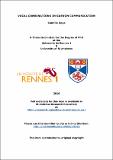Files in this item
Vocal combinations in guenon communication
Item metadata
| dc.contributor.advisor | Zuberbuhler, Klaus | |
| dc.contributor.author | Coye, Camille | |
| dc.coverage.spatial | 351 p. | en_US |
| dc.date.accessioned | 2018-07-23T13:49:17Z | |
| dc.date.available | 2018-07-23T13:49:17Z | |
| dc.date.issued | 2016 | |
| dc.identifier.uri | https://hdl.handle.net/10023/15650 | |
| dc.description.abstract | It is generally accepted that comparative studies on animal communication can provide insights into the coevolution of social life, vocal communication, cognitive capacities and notably the emergence of some human language features. Recent studies suggested that non-human primates possess combinatorial abilities that may allow a diversification of vocal repertoires or a richer communication in spite of limited articulatory capacities. However, the functions of combined calls and the information that receivers can extract remain poorly understood. This thesis investigated call combination systems in two species of guenons: Campbell’s monkey (Cercopithecus Campbelli) and Diana monkey (Cercopithecus Diana). Firstly, I studied the combinatorial structure and relevance to receivers of combined calls in of both species using playback experiments. Results confirmed the presence of a suffixation mechanism reducing the emergency of danger signaled by calls of male Campbell’s monkeys. Also, they showed that combined calls of females Diana monkeys convey linearly information via their two units, which signal respectively caller’s emotional state and identity. Secondly, focusing on the context associated with the emission of simple and combined female Campbell’s monkey calls, results revealed flexible use of combination reflecting the immediate need to remain cryptic (i.e. simple calls) or to signal caller’s identity (i.e. combined calls). Finally, I compared females’ communication systems of both species to identify their similarities and differences. As predicted by their close phylogenetic relatedness, their repertoires are mostly based on homologous structures. However, the females differ strongly in their use of those structures. In particular, the great number of calls combined by Diana monkeys increases considerably their vocal repertoire compared to Campbell’s monkeys. Given that the combinations are non-random, meaningful to receivers and used flexibly with the context, I propose a parallel with a rudimentary form of semantic morphosyntax and discuss more generally the possible existence of similar capacities in other non-human animals. | en |
| dc.language.iso | en | en_US |
| dc.publisher | University of St Andrews | |
| dc.subject.lcc | QL737.P93C7 | |
| dc.subject.lcsh | Cercopithecus | en |
| dc.subject.lcsh | Animal communication | en |
| dc.title | Vocal combinations in guenon communication | en_US |
| dc.type | Thesis | en_US |
| dc.type.qualificationlevel | Doctoral | en_US |
| dc.type.qualificationname | PhD Doctor of Philosophy | en_US |
| dc.publisher.institution | The University of St Andrews | en_US |
This item appears in the following Collection(s)
Items in the St Andrews Research Repository are protected by copyright, with all rights reserved, unless otherwise indicated.

